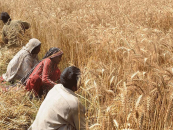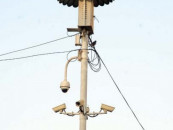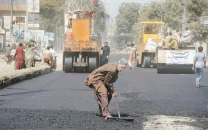Birds of a feather migrate together: Karachi’s native sparrows have flown the coop
Changing environment, lack of natural habitat results in decreasing population

But the city’s environment slowly started changing and soon those birds were no more.
The population of the house sparrow, the most common bird in Karachi at one time, began to decline as their natural habitat began to die out due to urbanisation. The sparrow was once so common in the city that it was visible not only in parks and perched on tree limbs, but also around people’s houses.
But as the bio-diversity of plants changed in the city, the avian population was also affected.
The birds are now only found around old native trees — neem, peepal, amaltas and gulmohar.
Artist paints serene colours of nature
Where did our feathered friends go?
The Express Tribune spoke to senior ornithologist Dr Syed Ali Ghalib about the disappearance of Karachi’s birds.
According to him, the situation is alarming. Our priorities are other species, such as the Houbara Bustard, and species like unglamorous sparrows are neglected.
Dr Ghalib said in the past decade there was an increase in the population of birds of prey such as kites and crows who fed on sparrows and their chicks. He said that one of the important reasons for the increase in their population is garbage. “We unfortunately produce garbage in sufficient amounts and leave out on the streets for ages. We have open slaughter houses and practices like sadqa, where people throw meat for kites and crows to eat,” he explained.
Wherever there is enough food for these birds of prey, the environment will suit them and their population will increase at a faster pace scaring the chirping birds away, he said.
Wildlife dept recovers turtle meat consignment
Dr Ghalib said sparrows are too small in size to defend themselves or their chicks and become an open feast for birds of prey.
Another important reason for their diminishing population is the lack of plant bio-diversity. The ornithologist said that without keeping in mind the consequences, plantation of trees like conocarpus was encouraged due to its rapid growth but no birds like nesting or even sitting in them.
He added that conocarpus actually changed the natural habitat of several birds, including sparrows. The native trees that once provided small fruit to the birds gradually vanished from the city.
“We need to control the population of kites and crows with proper garbage disposal, otherwise after a decade the situation will be so bad that we will only see sparrows caged in zoos,” said Dr Ghalib.
He pointed out that other than sparrows, there are several types of parrots that once populated the city but have now disappeared due to lack of trees.
He mentioned that as an ornithologist, he never wants to see sparrows on the list of rare birds in the city. The list includes doves, nightingales and chakor.
Tourism Day: ‘Tremendous potential exists in tourism sector’
Efforts across the border
The state of the sparrow population is the same across the border, as many environment-related organisations in India have been raising concerns over the matter. A notable effort in this direction is ‘Citizen Sparrow’, a citizen science initiative launched in 2012.
‘Citizen Sparrow’ is an ongoing science project in which members of the public are encouraged to contribute information on the presence and absence of the house sparrow. The project was conceived by the Bombay Natural History Society and Indian ministry of environment and forests in partnership with the National Centre for Biological Sciences and Nature Conservation Foundation.
During the project, 11,170 observations from 5,939 persons at 8,802 locations across India were gathered, according to the Citizen Sparrow website. Based on this, they have presented a summary of results: “Based on over 10,000 reports from across the country and from different years, some patterns are clear. Sparrow occurrence is reported to be lower at present than in the past, and this is consistent across the country in India.”
Rescuers help save 27 birds, 14 animals
The birds and the bees
Environmentalist Dr Zafar Iqbal Shams pointed out that decreasing population is not a problem limited to sparrows alone, as the population of colourful butterflies is also falling due to changes in its natural habitat.
Explaining the relationship between plants and birds, Dr Shams said that the number of plants is directly proportional to the number of birds and the decreasing number of native plants had led to a decrease in the native birds of the city.
He cited the example of a neem tree and a Bargad tree, explaining that a single tree hosts hundreds of birds that feed on their fruit or leaves. If they are suddenly chopped down and replaced with a foreign species like conocarpus, there will be a great stress on these birds due to the sudden change in their natural habitat, he said. The birds will either die due to lack of food or migrate to some other location, said the environmentalist.
He said that this is what happened in Karachi as hundreds and thousands of trees were replaced by conocorpus, which created a huge environmental problem in the city.
Migratory Guests: K-P opens season on cranes
The same is the case with butterflies, said Dr Shams, adding that small flowered plants were once seen in parks, green belts and houses but they too were unfortunately replaced by conocarpus. Obviously, butterflies feed on the nectar of flowers, which conocarpus does not produce, he said.
Ecologist Rafiul Haq said there is a dire need of a balanced population of birds. He gave the example of the increased population of pigeons, which are often seen perched on different roundabouts where passers-by feed them as a good deed. This practice has increased the population of pigeons tenfold, he said.
Haq added that if pigeons are increased in certain areas then there will be a burden on food resources, as there must have been another species of bird living there. This results in migration of existing native birds, which are usually sparrows. He added that just like pigeons, the increased population of mynahs has also affected population of house sparrows.
Govt imposes ban on hunting ‘Lali’
He added that everything is connected — large trees have insects that are food for sparrows but the lack of large trees has resulted in a lack of insects, therefore sparrows have decreased in the city.
“Where do you want them to make their nests?” he asked. “On balconies or on windows? Humans have removed all the trees and instead of large trees we have huge plazas. Unfortunately, instead of seeing sparrows in trees we find them in the gaps between shutters, which is not a suitable breeding ground.” Haq explained that due to long-term exposure to low-intensity electromagnetic radiation from mobile phone base stations breeding season, birds are highly sensitive to electromagnetic waves and small chicks can die due to them.
Wildlife dept recovers eight endangered falcons
Same is the case of cuckoos that chose to nest in mango trees and entertain us with their melodious voices, however, a lack of mango trees has led to a decreased population of cuckoo bird, he lamented.
He mentioned that this is the result of our unfriendly behaviour towards nature. “I fear that we will not be able to see common birds such as house sparrows in the city after several years if the situation remains the same,” said Haq.
Changes in our urban environment occur too slowly, he said, adding that their consequences will be long term. “It’s not just sparrows that are disappearing from our cities but other forms of urban wildlife like butterflies and frogs as well,” he said.
We may be able to send a man to the moon but it is impossible to bring back an extinct species, he warned.



















COMMENTS
Comments are moderated and generally will be posted if they are on-topic and not abusive.
For more information, please see our Comments FAQ